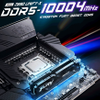MSI OC Team just announced the overclocking of Kingston Fury Beast DDR5 RAM to DDR5-10004.
The team used an MSI UNIFY-X motherboard equipped with a Core i9-12900KS CPU running at 425 MHz. At 5001.8 MHz, the memory has a timing of 72-126-126-126-127-2, which is required for 10004 MT/s.
MSI and Kingston have a long history of co-developing memory optimization and overclocking technologies. MSI even throws in a 6000 MT/s Kingston RAM kit with their MEG Z690 GODLIKE motherboard. Memory manufacturers have suggested that they intend to introduce 10-12 GT/s memory in the future.


